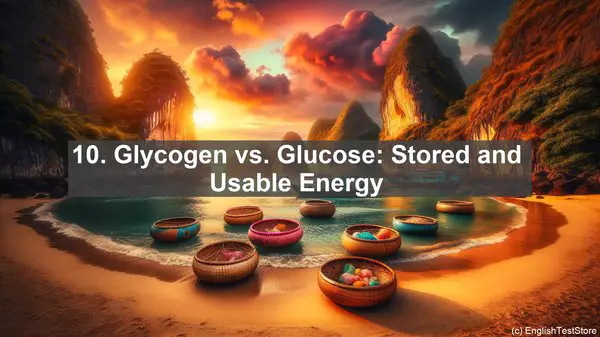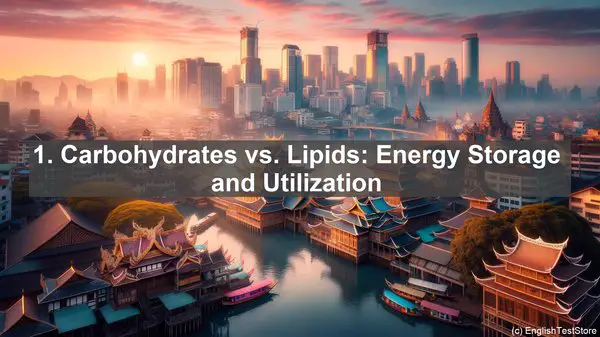Introduction: The Importance of Precise Terminology
When it comes to nutritional biochemistry, precision is key. The field is filled with terms that may seem similar but have distinct meanings. Today, we’ll dive into the top 10 words that often cause confusion. By the end of this lesson, you’ll have a solid grasp of these terms, setting a strong foundation for your studies.
1. Carbohydrates vs. Lipids: Energy Storage and Utilization
Carbohydrates and lipids are both energy sources, but they differ in their roles. Carbohydrates are the body’s primary fuel, providing quick energy. Lipids, on the other hand, are excellent for long-term energy storage. Understanding this difference is crucial for designing balanced diets and managing energy levels.
2. Proteins vs. Amino Acids: Building Blocks of Life
Proteins are often referred to as the ‘building blocks of life.’ But it’s important to note that proteins are made up of amino acids. Amino acids are the individual units that combine to form proteins. Each amino acid has a unique role, and their arrangement determines the protein’s function. So, while proteins are essential, it’s the amino acids that make them up.

3. Vitamins vs. Minerals: Micronutrients for Health
Vitamins and minerals are both crucial for our well-being, but they have different roles. Vitamins are organic compounds that the body needs in small amounts. They play vital roles in various bodily functions. Minerals, on the other hand, are inorganic elements. They’re equally important, but the body requires them in larger quantities compared to vitamins.
4. Monounsaturated vs. Polyunsaturated Fats: The Good Fats
When it comes to fats, not all are created equal. Monounsaturated and polyunsaturated fats are the ‘good’ fats. They’re heart-healthy and can help lower bad cholesterol levels. While they have similar benefits, their chemical structures differ. This variance impacts their functions in the body, making it important to include both in our diets.
5. Glycolysis vs. Gluconeogenesis: Energy Pathways
Glycolysis and gluconeogenesis are both involved in energy metabolism, but they have opposite functions. Glycolysis is the breakdown of glucose to produce energy, while gluconeogenesis is the synthesis of glucose from non-carbohydrate sources. These processes are tightly regulated and ensure a constant supply of glucose, the body’s preferred energy source.
6. Catabolism vs. Anabolism: Breaking Down and Building Up
Catabolism and anabolism are two sides of the metabolic coin. Catabolism involves the breakdown of complex molecules into simpler ones, releasing energy. Anabolism, on the other hand, is the synthesis of complex molecules from simpler ones, requiring energy. Together, these processes maintain the body’s equilibrium and ensure proper functioning.

7. Essential vs. Non-Essential Amino Acids: Dietary Importance
Amino acids are classified as essential or non-essential. Essential amino acids are those that the body can’t produce, so we must obtain them from our diet. Non-essential amino acids, on the other hand, can be synthesized by the body. Both types are crucial for protein synthesis and various physiological processes.
8. Endocrine vs. Exocrine Glands: Hormone Release
Endocrine and exocrine glands are involved in hormone release, but they differ in their mechanisms. Endocrine glands secrete hormones directly into the bloodstream, while exocrine glands release substances through ducts. This distinction is important as it determines how hormones reach their target tissues and exert their effects.
9. Saturated vs. Unsaturated Fats: The Not-So-Good Fats
Unlike monounsaturated and polyunsaturated fats, saturated fats aren’t as heart-healthy. They’re mainly found in animal sources and can raise bad cholesterol levels. Unsaturated fats, on the other hand, can have the opposite effect. By understanding the differences, we can make informed choices about our fat intake.
10. Glycogen vs. Glucose: Stored and Usable Energy
Glycogen and glucose are both forms of energy storage, but they have different functions. Glycogen is the body’s stored form of glucose, acting as a readily available energy source. Glucose, on the other hand, is the primary fuel for our cells. This duality ensures a constant supply of energy, even during periods of fasting or intense activity.
